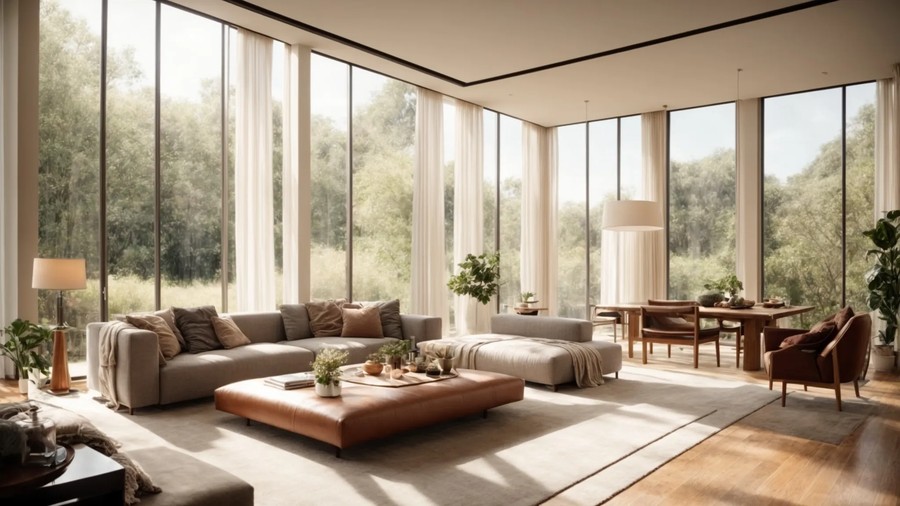Maximizing Natural Light: Innovative Window Placement Ideas

In today’s fast-paced world, where many of us spend hours indoors, the value of natural light cannot be overstated. It boosts mood, enhances productivity, and even improves health by regulating circadian rhythms and reducing reliance on artificial lighting. But achieving optimal natural light isn’t just about installing bigger windows (fenster)—it’s about smart, innovative placement that considers your home’s layout, orientation, and lifestyle. If you’re renovating, building new, or simply looking to brighten up your space, this guide explores creative window placement ideas to maximize sunlight. From strategic room-specific designs to cutting-edge architectural tricks, we’ll cover how to flood your home with daylight while maintaining energy efficiency and aesthetic appeal.
Whether you’re dealing with a cozy apartment or a sprawling suburban house, these tips can transform dim corners into vibrant havens. Let’s dive into the art of window placement and discover how small changes can make a big difference.
Why Natural Light Matters in Modern Homes
Before we jump into placement ideas, it’s essential to understand why maximizing natural light is a game-changer. Studies show that exposure to daylight can reduce stress, improve sleep quality, and even lower energy bills by cutting down on electric lights during the day. In fact, homes with abundant natural light often feel larger and more inviting, which can increase property value—real estate experts note that well-lit spaces sell faster and at higher prices.
However, not all homes are blessed with ideal sun exposure. Factors like building orientation, surrounding structures, and climate play a role. That’s where innovative window placement comes in. By thoughtfully positioning windows, you can capture sunlight at different times of the day, creating a dynamic interplay of light and shadow that enhances your interior design. This approach goes beyond traditional setups, incorporating modern elements like smart glass and unconventional shapes to suit contemporary living.
Room-by-Room Window Placement Strategies
Every room in your home has unique lighting needs, so tailoring window placement to function is key. Here’s how to optimize each space for maximum natural light without compromising privacy or comfort.
Living Rooms: Creating Welcoming Gathering Spaces
The living room is often the heart of the home, where family and friends convene. To maximize natural light here, consider south-facing windows for consistent daylight in the Northern Hemisphere. A popular innovative idea is installing floor-to-ceiling glass panels or sliding doors that open to a patio, blurring the line between indoors and out. This not only floods the room with light but also creates an illusion of expanded space.
For homes with limited wall space, try clerestory windows—high-placed horizontal strips just below the ceiling. These allow light to penetrate deep into the room without sacrificing wall area for furniture or art. Pair them with light-reflective surfaces like white walls or mirrors to amplify the effect. In one case study from a Seattle-based architect, adding clerestory windows increased perceived room brightness by 40%, making the space feel airy even on cloudy days.
Kitchens: Brightening the Culinary Hub
Kitchens benefit immensely from natural light, as it makes food prep safer and more enjoyable. An innovative placement idea is to position windows above countertops or sinks, often called “garden windows” that protrude outward like mini greenhouses. These capture morning light perfectly for east-facing kitchens, ideal for breakfast nooks.
For open-concept designs, consider transom windows above doorways or cabinets to let light flow from adjacent rooms. If privacy is a concern in urban settings, frosted or textured glass maintains light intake while obscuring views. Homeowners who’ve implemented these changes report reduced eye strain and a more vibrant atmosphere, turning mundane meal times into delightful experiences.
Bedrooms: Promoting Restful Ambiance
Bedrooms require a balance—ample morning light to wake naturally, but options for darkness at night. East-facing windows are excellent for gentle sunrise illumination, but add blackout curtains for control. An innovative twist is bay windows with built-in seating, which not only maximize light but also provide a cozy reading spot.
In smaller bedrooms, use corner windows to draw light from two directions, reducing shadows and making the room feel larger. For loft-style homes, skylights directly above the bed can simulate sleeping under the stars, with motorized shades for practicality. This setup has been praised in wellness-focused designs for improving sleep hygiene by aligning with natural light cycles.
Bathrooms: Enhancing Hygiene and Relaxation
Bathrooms often get shortchanged on windows due to privacy issues, but innovative placements can change that. Frosted skylights or high-placed awning windows allow light in while keeping prying eyes out. For a spa-like feel, install a picture window with a view of greenery, using one-way film for discretion.
In compact bathrooms, tubular skylights—small, reflective tubes that channel sunlight from the roof— are a space-saving marvel. They deliver bright, diffused light without taking up wall space, perfect for urban apartments. Users often note how this transforms a once-dreary shower into a refreshing oasis, boosting daily routines.
Innovative Window Types for Maximum Light Capture
Beyond placement, the type of window you choose can revolutionize light intake. Here are some cutting-edge options that push the boundaries of traditional design.
Skylights and Roof Windows: Overhead Illumination
Skylights are a timeless way to maximize natural light, especially in rooms with limited wall space. Modern versions include vented models for airflow and solar-powered ones that adjust tint based on sunlight intensity. For sloped roofs, fixed skylights can create dramatic light wells, while in flat-roof homes, dome-shaped ones diffuse light evenly.
An emerging trend is “light tunnels” for interior rooms without direct roof access, piping sunlight through reflective tubes. These are ideal for hallways or closets, adding unexpected brightness and reducing energy use.
Clerestory and Transom Windows: High-Level Lighting
Clerestory windows, placed high on walls, capture zenith light (from directly overhead) and distribute it downward. They’re perfect for privacy-focused areas and can be automated with smart home systems for optimal control.
Transom windows, small panes above doors or larger windows, facilitate light flow between rooms. In multi-story homes, stacking them creates a “light chimney” effect, drawing sunlight from upper levels to lower ones.
Bay, Bow, and Picture Windows: Expansive Views
Bay windows protrude from the wall, creating a three-dimensional light catcher that pulls in rays from multiple angles. Bow windows, with their curved design, offer even more panoramic light intake.
Large picture windows serve as focal points, framing outdoor views while maximizing daylight. Tempered glass and low-E coatings ensure they’re energy-efficient, preventing heat loss in winter.
Harnessing Sun Orientation for Optimal Placement
Window placement isn’t random—it’s guided by the sun’s path. In the Northern Hemisphere, south-facing windows provide the most consistent light year-round, ideal for passive solar heating. East-facing ones catch morning sun for energizing starts, while west-facing capture afternoon warmth but may need shades to avoid glare.
North-facing windows offer soft, diffused light without direct sun, perfect for art studios or offices. Tools like sun path diagrams or apps can help map your home’s exposure. For example, in equatorial regions, overhead shading like eaves prevents overheating while allowing light in.
Overcoming Challenges in Small or Urban Spaces
Urban dwellers often face obstacles like tall buildings blocking light. Innovative solutions include light shelves—horizontal surfaces that bounce sunlight deeper into rooms—or mirrored courtyards that reflect rays.
In tiny homes, multi-functional windows like foldable ones or those integrated into furniture maximize utility. Vertical gardens outside windows can filter light softly, adding greenery without dimming interiors.
Energy Efficiency and Sustainable Practices
Maximizing natural light aligns with green living. Energy-efficient windows with double glazing and argon gas reduce heat transfer, lowering bills. Sustainable materials like recycled aluminum frames minimize environmental impact.
Integrate smart tech: Sensors that adjust blinds based on light levels or photovoltaic windows that generate electricity while letting light through. These innovations ensure your bright home is also eco-friendly.
Final Thoughts: Illuminate Your Life
Incorporating innovative window placement ideas can dramatically enhance your home’s natural light, creating spaces that are healthier, more efficient, and simply more enjoyable. Start small—assess your current setup, consult a professional, and experiment with one or two changes. Whether it’s adding a skylight or repositioning a window, the results can be transformative.
Ready to brighten your world? Explore local architects or window suppliers to bring these ideas to life. Your sun-drenched sanctuary awaits!

